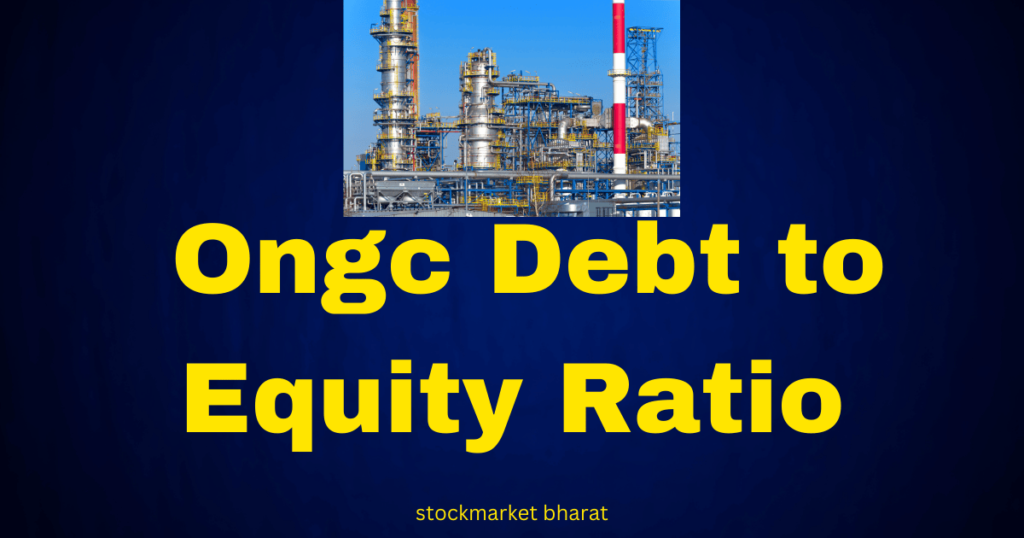ONGC DEBT TO EQUITY RATIO:
Understanding ONGC’s Debt to Equity Ratio: A Key Financial Indicator
When analyzing a company’s financial health, one of the most crucial metrics investors consider is the debt to equity ratio. For a company like Oil and Natural Gas Corporation (ONGC), India’s largest oil and gas exploration company, this ratio plays a significant role in determining its financial stability and investment appeal. In this blog, we will explore what the debt to equity ratio is, ONGC’s financial standing, and how it impacts investors.

What is the Debt to Equity Ratio?
The debt to equity (D/E) ratio is a financial metric that measures the relative proportion of a company’s debt to its shareholder equity. It is calculated using the formula:
Debt to Equity Ratio=Total DebtTotal Shareholder Equity\text{Debt to Equity Ratio} = \frac{\text{Total Debt}}{\text{Total Shareholder Equity}}
This ratio helps investors understand how much a company relies on borrowed funds versus its own equity for financing its operations and expansion.
Importance of Debt to Equity Ratio in Financial Analysis
- Indicates Financial Leverage: A high ratio suggests that the company relies more on debt financing, which can be risky if earnings fluctuate.
- Risk Assessment: A low ratio indicates financial stability and lower risk, while a high ratio might signal higher financial risk.
- Investment Decision Making: Investors use this ratio to assess whether a company is a safe or risky investment.
- Comparing Industry Standards: The D/E ratio should be compared with industry peers to determine whether the company’s leverage is reasonable.
ONGC’s Debt to Equity Ratio: A Detailed Analysis
ONGC, being a state-owned oil and gas company, operates in a capital-intensive industry. The company requires significant investments in oil exploration, refining, and production, leading to fluctuations in its debt levels.
Current Debt to Equity Ratio of ONGC
(As financial data is subject to change, please check the latest reports for updated figures.)
- As per the latest available data, ONGC’s debt to equity ratio stands at approximately 0.48.
- Comparing to industry standards, ONGC’s ratio is relatively stable, reflecting its strong financial position.
- Despite fluctuations in global crude oil prices, ONGC has managed to maintain a healthy balance between debt and equity.
Why ONGC’s Debt to Equity Ratio Matters for Investors
1. Strong Financial Stability
- ONGC has historically maintained a low to moderate debt level, ensuring long-term financial health.
- The company’s strong cash flow from operations helps in managing its debt effectively.
2. Government Backing and Stability
- Since ONGC is a Public Sector Undertaking (PSU), it benefits from government support in terms of policies and funding.
- This reduces default risk, making it a relatively safe investment choice.
3. Impact of Oil Prices on Debt Levels
- ONGC’s revenue is significantly impacted by global crude oil prices.
- Higher oil prices lead to increased revenues, allowing the company to reduce debt levels.
- Lower oil prices might increase dependency on external borrowings, slightly impacting the D/E ratio.
4. Expansion and Capital Expenditures
- ONGC is continuously investing in new exploration projects, renewable energy, and infrastructure.
- These investments are partially funded through debt, affecting the debt to equity ratio temporarily.
Comparing ONGC’s Debt to Equity Ratio with Peers
To get a clearer picture, it’s essential to compare ONGC’s debt to equity ratio with other major players in the oil and gas sector:
| Company | Debt to Equity Ratio (Latest) |
|---|---|
| ONGC | 0.48 |
| Reliance Industries | 0.64 |
| Indian Oil Corporation (IOC) | 0.65 |
| Bharat Petroleum (BPCL) | 0.75 |
(Please verify the latest numbers before making investment decisions.)
Factors Affecting ONGC’s Debt to Equity Ratio
Several factors influence ONGC’s financial leverage:
- Oil Price Volatility: Changes in crude oil prices directly impact profitability and borrowing needs.
- Government Policies: Subsidies, tax benefits, and regulatory changes affect financial planning.
- Global Energy Trends: The shift toward renewable energy sources may require additional investments, impacting the debt ratio.
- Dividend Payouts: High dividend payouts can reduce retained earnings, altering the D/E ratio.
- Interest Rates: Fluctuating interest rates on loans impact borrowing costs and financial leverage.
Should You Invest in ONGC Based on Its Debt to Equity Ratio?
Pros of Investing in ONGC
✔ Stable PSU with government backing ✔ Consistent dividend payouts ✔ Strong operational cash flows ✔ Low to moderate financial risk
Cons of Investing in ONGC
❌ Highly dependent on crude oil prices ❌ Capital-intensive industry with fluctuating expenses ❌ Shift towards renewable energy may impact long-term growth
Final Thoughts
ONGC’s debt to equity ratio is an important metric for evaluating its financial health and investment potential. While the company maintains a strong balance sheet, investors should also consider other financial indicators like return on equity (ROE), profit margins, and cash flow trends before making investment decisions.
For long-term investors seeking stable returns with moderate risk, ONGC remains an attractive option in the Indian stock market. However, keeping an eye on oil price fluctuations and government policies is crucial for making informed investment choices.
Would you consider ONGC as a part of your investment portfolio? Let us know in the comments!
Disclaimer: This article is for informational purposes only and should not be considered financial advice. Please consult a professional financial advisor before making investment decisions.
WORTH A READ: small-cap-energy-stocks